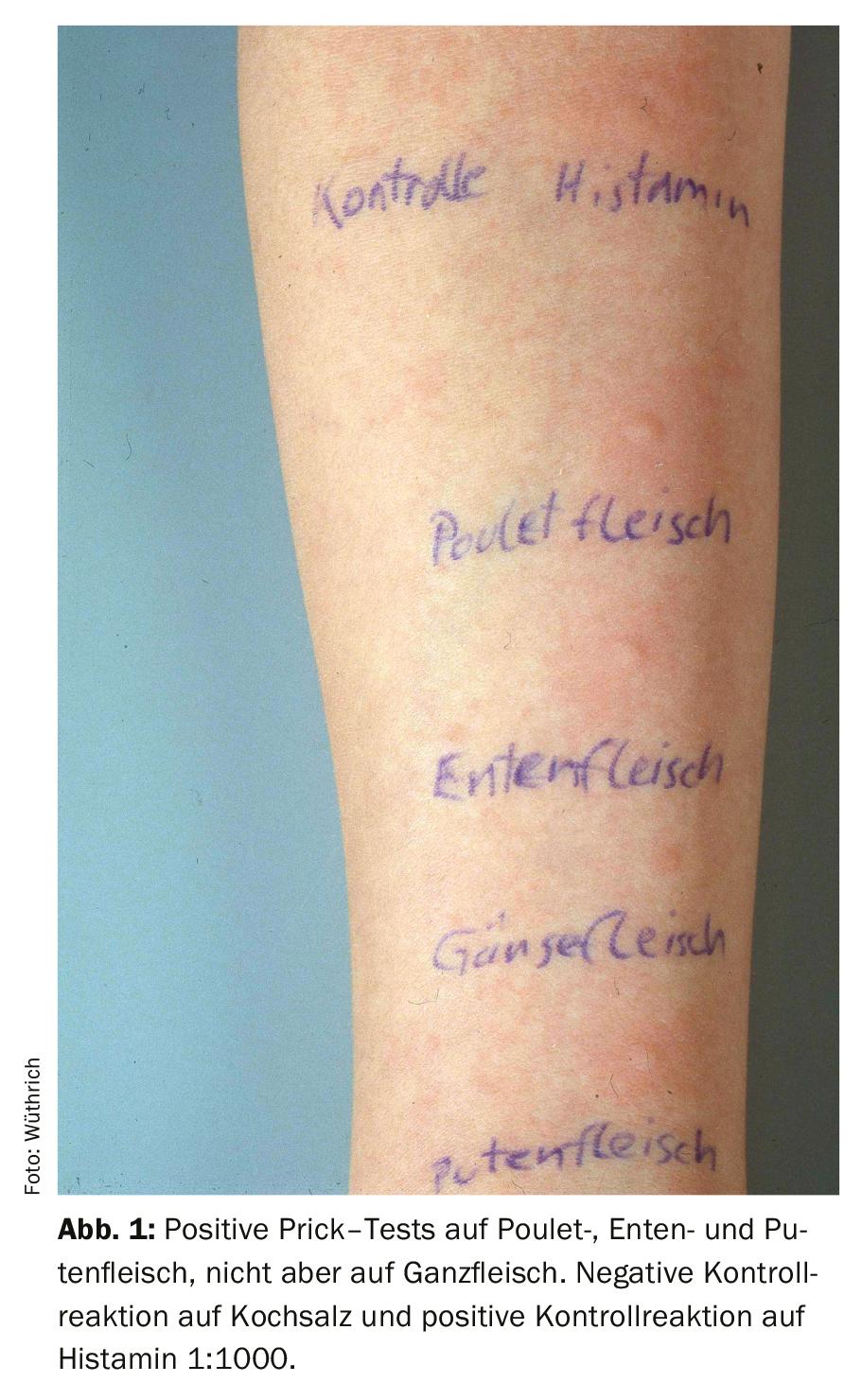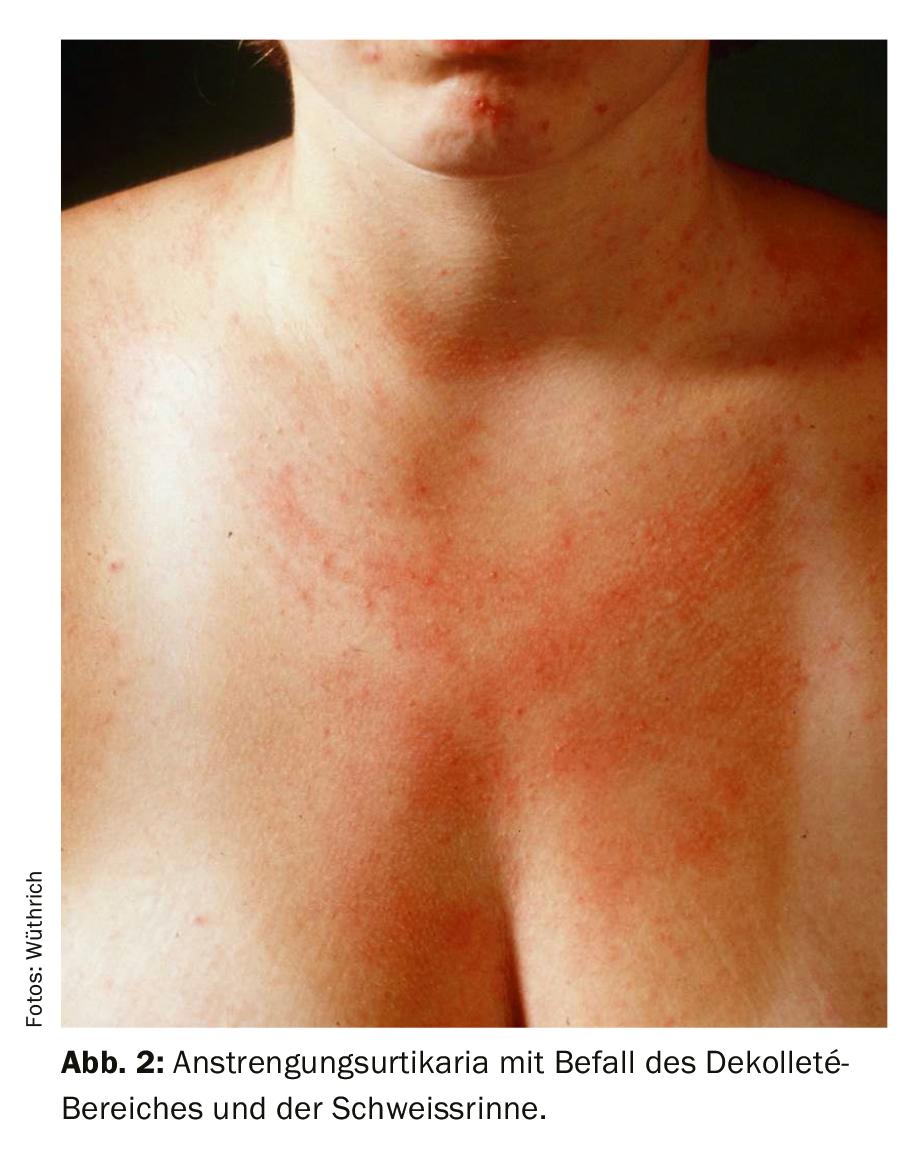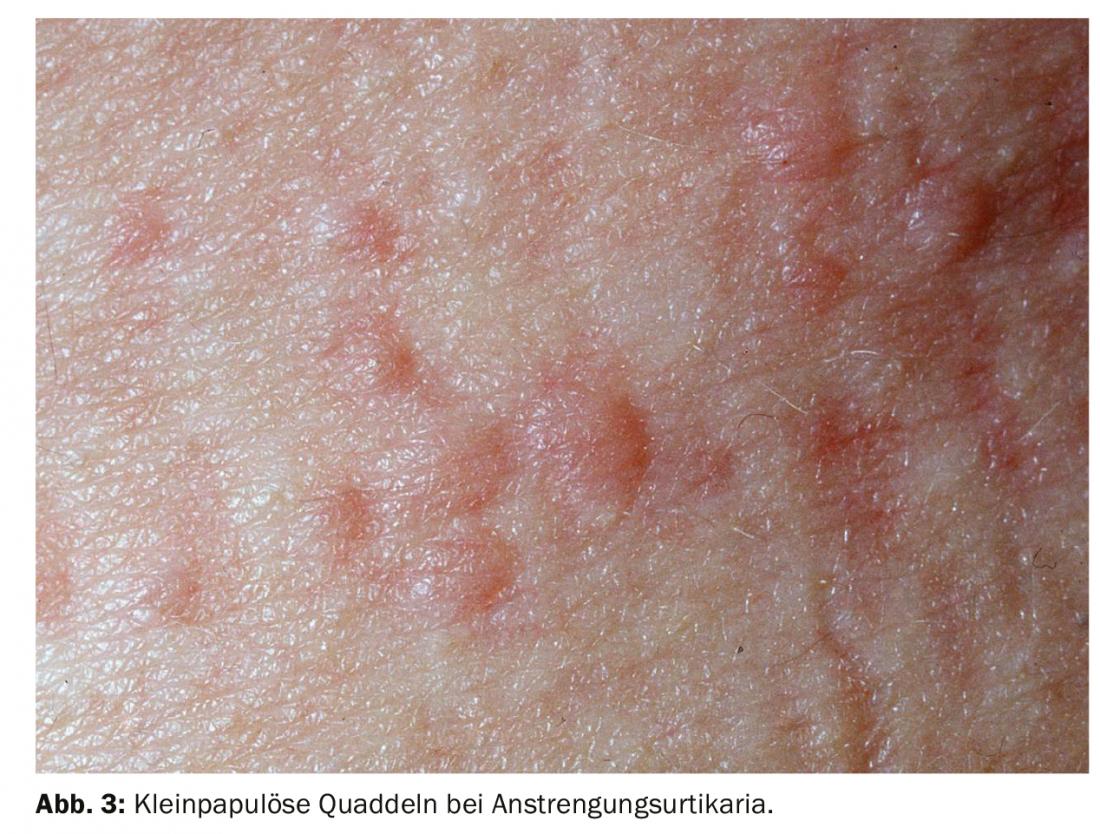A common subtype of inducible urticaria is cholinergic urticaria. Trigger factor is an increase in body temperature caused by physical exertion, hot baths or warm drinks. Emotionally upset mood is also a possible trigger. Itching, redness and wheals occur mostly on the neck and upper body.
History: 10-year-old student Anne-Katrin H. suffered generalized, intensely pruritic urticarial exanthema three times during gym class at school.
Allergological clarification
With this history and absence of indications for other diseases from the atopic group (hay fever, asthma or neurodermatitis), one thinks primarily of an effort urticaria (cholinergic urticaria) [1]. In atopy screening by prick tests for inhalant allergens, incl. latex, there were no immediate reactions. An effort test using a bicycle ergometer and also after climbing stairs was negative. The complementary history in the presence of the mother revealed that gymnastics classes are held once a week, for one hour in the afternoon (2:00 pm), after the meal at home. However, the urticaria had not occurred every time during gymnastics, nor otherwise during recreational sports activities.
My thoughts were now whether it could be a food-dependent, exercise-induced urticaria [2]. The mother mentioned that she cooks poulet (chicken) every two weeks on this gym class day. However, her daughter has recently had an “aversion” to poultry meat: it “sticks in her throat” and she feels a “scratchy sensation”.
Extended allergological clarification
Prick tests for a wide range of food allergens (Stallergènes Lab.) showed positive immediate reactions to chicken meat, duck meat, and turkey meat, whereas all others, especially goose meat, egg white, and egg yolk, were negative (Fig. 1).

Serum IgE determinations (CAP, Pharmacia, now ThermoFisher) showed an elevated value of class 3 (6.2 kU/L) on chicken meat, class 1 on turkey, whereas chicken egg, egg yolk, chicken feather, pollen and mite mix were class 0 negative.
Diagnosis
Effort-induced food allergy in monovalent sensitization to poultry meat.
Course
The mother and student were advised to maintain strict poultry meat elimination not only before gym class but also elsewhere, in the hope that after several months of abstinence, the monovalent sensitization would attenuate or disappear. After the follow-up examination one year later, no more adverse events had occurred and there was a decrease in IgE chicken sensitization to CAP class 2 (1.87 kU/L).
Comment
Exertional urticaria: A common subtype of inducible urticaria is cholinergic urticaria (synonyms: exertional urticaria, sweating urticaria, or heat urticaria). Itching, redness, and pinhead-sized wheals, which usually appear on the neck and upper body along the sweat ducts (Figs. 2 and 3), occur in cholinergic urticaria due to an increase in body temperature, such as that caused by physical exertion, hot bathing, or hot drinks, but also in an emotionally agitated mood. Symptoms begin within minutes of the body temperature rising by about one degree; when the body temperature drops again, the wheals usually disappear within minutes to hours. Once the wheals have disappeared again, they cannot be triggered again for up to 24 hours, as the responsible mast cells can only release histamine again after the so-called refractory period. The nervous system and its messengers are involved in the development of cholinergic urticaria [1]. Besides urticaria factitia, cholinergic urticaria is one of the most common forms of urticaria. Young adults between the ages of 15 and 35 are most commonly affected [3].

The diagnosis of cholinergic urticaria is made by an exercise test: The patient cycles warmly dressed (e.g., with a plastic telerine cover) on a cycle ergometer until he or she begins to sweat – and for another 20 minutes beyond that point. If the symptoms can be triggered by the increased body temperature, cholinergic urticaria is present. People with cholinergic urticaria should avoid the previously mentioned triggers. Since this is not always possible, fast-acting, nonsedating second-generation antihistamines, such as fexofenadine, are used to relieve symptoms.
Food-dependent exercise-induced anaphylaxis: In so-called “food-dependent exercise-induced anaphylaxis” (FDEIA), which was first described in 1983 by Kidd et al. 4], only simultaneous exposure to physical exertion and ingestion of the food to which IgE sensitization exists leads to acute clinical symptoms, whereas exertion alone or ingestion of the food alone is unreactive [5,6]. Food-induced, exercise-induced anaphylaxis must be distinguished from exercise-induced anaphylaxis (“EIA”) and so-called idiopathic anaphylaxis (IA) [7,8].

Wheat flour is one of the most commonly implicated foods in FDEIA [9,10] and the allergen identified is the gliadin fraction, namely the rTri-α- omega-5 gliadin [11,12]. We ourselves were able to publish a corresponding case [13]. However, not only wheat, but also other various allergens, such as crustaceans or sesame seeds, can trigger FDEIA [14,15].
Poultry meat allergy: Allergies to poultry meat are rare and can occur in childhood and adulthood [16–19]. Reliable prevalence figures do not exist, presumably they are comparably frequent as allergies to red meat, to which there is no close relationship. Basically, a distinction can be made between primary (genuine) and secondary, cross-reaction-based poultry meat allergies [16]. Genuine poultry meat allergies are found primarily in adolescents and young adults, with initial manifestation often occurring during preschool and elementary school age. Simultaneous egg allergy is not obligatory. Severe anaphylaxis with cardiovascular symptoms is rare [19]. Chicken and the highly cross-reactive turkey meat usually cause comparably severe reactions, while duck and goose meat usually cause milder or no reactions [16]. Primarily low molecular weight proteins between 5 and 25 kDa have been described as responsible allergens in genuine chicken allergies [16]. One of these proteins was identified as α-parvalbumin, which cross-reacts with homologous proteins in red meat. We ourselves were able to report on two patients with ingestive, monovalent allergy to chicken and turkey meat with Yves Cahen, MD [20]. By SDS-PAGE and immunoblotting, proteins with MG of 21, 23, and 50 kDa were identified as allergens. Another marker band was detected at 91 kDa for turkey. Immunoblot inhibition was able to confirm chicken and turkey allergen cross-reactivity [20].
Conclusions
Chicken allergy is a well-defined entity with cross-reactivity within poultry meat, particularly turkey. Poultry meat allergy can also occur monovalently, in the sense of a type 3 food allergy [21] or as FDEIA, as described in our case report. In contrast to the avian egg syndrome [16], a situation we will report in a next paper, patients can tolerate egg and egg products.
Literature:
- Urticaria Diary: www.hautwende.de/nesselsucht/formen/cholinergische-urtikaria, last accessed 01/06/2010.
- Wüthrich B: What is your diagnosis? Food-induced exertion-induced anaphylaxis in cases of severe sensitization to cereal proteins, especially to rTri α 19-omega-5-gliadin. DERMATOLOGIE PRAXIS 2013/1: 25 and 32-33.
- Zuberbier T, Althaus C, Chantraine-Hess S, Czarnetzki BM: Prevalence of cholinergic urticaria in young adults. J Am Acad Dermatol 1994; 31(6): 978-981.
- Kidd JM, Cohen SH, Sosman AJ, Fink J: Food-dependent exercise-induced anaphylaxis. J Allergy Clin Immunol 1983; 71(4): 407-411.
- Sheffer AL, Austen KF: Exercise-induced anaphylaxis. J Allergy Clin Immunol 1984; 73: 699-703.
- Steurich F, Feyerabend R: Food-induced exertion-induced anaphylaxis. Allergology 2000: 23: 219-228.
- Hogan MB: Progress toward an understanding of idiopathic anaphylaxis. Ann Allergy Asthma Immunol 2000; 85: 332-333.
- Lenchner K, Grammer LC: A current review of idiopathic anaphylaxis. Curr Opin Allergy Clin Immunol 2003; 305-311.
- Kushimoto H, Aoki T: Masked type I wheat allergy. Relation to exercise-induced anaphylaxis. Arch Dermatol 1985; 121: 355-360.
- Gall H, Steinert M, Peter RU: Exercise-induced anaphylaxis to wheat flour. Allergy 2000; 55(11): 1096-1097.
- Morita E: Diagnostic test using recombinant omega-5 gliadin for wheat-dependent, exercise-induced anaphylaxis. New Horizons – Allergy 2007;1: 1-4.
- Matsuo H, Kohno K, Niihara H, Morita E: Specific IgE determination to epitope peptides of omega-5 gliadin and high molecular weight gluteninsubunit is a useful tool for diagnosis of wheat-dependent exercise-induced anaphylaxis. J Immunol 2005; 175(12): 8116-8222.
- Wüthrich B, Hofer Th: Food-induced exertion-induced anaphylaxis in severe sensitization to cereal proteins, nparticularly to omega-5 gliadin, and in questionable house dust mite crustacean syndrome. Allergology 2010; 33: 205-210.
- Beaudouin E, et al: Food-dependent exercise-induced anaphylaxis – update and current data. Eur Ann Allergy Clin Immunol 2006; 38(2): 45-51.
- Gravett CM, Motala C: Food-dependent exercise-induced anaphylaxis associated with sesame seed ingestion – a case report. Curr Allergy Clin Immunol 2007; 20(4): 216-217.
- Hemmer W, Christoph Klug Chr, Swoboda I: Bird-egg syndrome and genuine chicken allergy. Allergo J 2016; 25(3): 22-19. https://doi.org/10.1007/s15007-016-1073-2.
- Martínez Alonso JC, Domínguez Ortega FJ, Fuentes Gonzalo MJ: Angioedema due to sensitization to chicken meat. Allergol Immunopathol (Madr) 2003; 31: 50-52.
- Vila L, Barbarin E, Sanz ML: Chicken meat induces oral allergy syndrome: a case report. Ann Allergy Asthma Immunol 1998; 80(2): 195-196.
- Cheikh Rouhou S, et al: Anaphylaxis due to chicken meat. Rev Mal Respir 2012; 29(1): 98-100.
- Cahen YD, Fritsch R, Wüthrich B: Food allergy with monovalent sensitivity to poultry meat. Clin Exp Allergy 1998; 28(8): 1026-1030.
- Pichler WJ: IgE-mediated food allergies. Classification based on sensitization pathway. Allergology 1998; 21, 441-450.
DERMATOLOGY PRACTICE 2020; 30(1): 7-9











